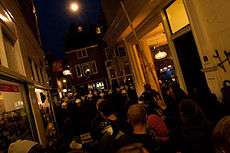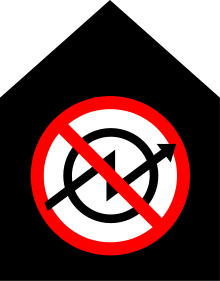Dutch squatting ban
The Dutch squatting ban refers to the law (Dutch: Wet Kraken en Leegstand) introduced on 1 October 2010, under which squatting in the Netherlands became de jure illegal. There were riots in Amsterdam and Nijmegen and several other protests. Squatters converged, occupying a former fire station.[1]
 Protesters confront police in Amsterdam over the squatting ban | |
| Date | 1 October 2010 |
|---|---|
| Location | Amsterdam, other cities in the Netherlands |
History
In 1978, the Council of Churches launched a protest which scotched a proposal to criminalise squatting. In June 2006, two ministers from the Dutch government (Sybilla Dekker and Piet Hein Donner) proposed a plan to make squatting illegal.[2] Other ministers, such as Alexander Pechtold, were not in favor of this plan. Representatives of the four largest Dutch cities wrote a letter stating that it would not be in their interest to ban squatting.[3] Squatters nationwide made banners and hung them on their squats in protest.[4]
Action

Several parties, notably the VVD party, were vocal critics of squatting. Backed by the leader of the PVV, Geert Wilders, they moved to outlaw squatting.[5] The new squatting ban was passed by the House of Representatives on 15 October 2009 and the Senate on 1 June 2010, and became law on 1 October 2010. The penalty is one year's imprisonment or more, if violence is involved.[6] Mayor of Amsterdam Eberhard van der Laan, and police commissioner Leen Schaap stated their joint intention to clear roughly 200 of 300 squats in Amsterdam, and to treat squatting as a criminal offence.[7][8][9]
Sociologist E.T.C. Dee observes that there was a moral panic generated in the Dutch media regarding three accusations made by the police concerning booby traps and weapons caches in the squats of Amsterdam. Thus the squatters' movement was seen as increasingly violent and needing to be regulated.[10]
Criminalization
The recently elected coalition government proposed a squatting ban on 1 June. The law was passed by both houses of parliament and came into force on 1 October. Former moves to ban squatting had been unsuccessful. In June 2006, ministers Sybilla Dekker and Piet Hein Donner from the Dutch government proposed a plan to criminalise squatting.[11][12] Other ministers, such as Alexander Pechtold, were not in favour. Representatives of the four largest Dutch cities wrote a letter stating that it would not be in their interests to proceed with a ban.[13] Squatters nationwide made banners, hanging them on their squats in protest.[14]
Reaction
In the run-up to the ban, there was an overnight sit-in at Dam Square on 25 September.[15] A former fire station was occupied next day,[16][17] but the building was handed back to its tenants before the squatting ban came into effect on 1 October.[18]
Squatting became a criminal offence at midnight on 1 October 2010, passing from the civil courts to the criminal courts. An Amsterdam protest numbering 800–1000 by various estimates occurred during the day.[5][9][19] By nightfall police charged protesters initiating violence.[20][21] Protesters responded throwing stones, bricks and bottles at police and vandalising cars. Protesters built ad hoc street barricades from metal fences and bicycles[6][22] to repel police charges in armoured vans and on horseback.[20] The police response included the use of bulldozers and water cannon to clear streets and extinguish fires.[5] Another protest occurred the next day in Nijmegen.[23] Police dispersed the protest by force and closed down the central station, arresting protesters present.[20] In Amsterdam that same evening, the police station was attacked by Molotov cocktails. The mayor, Eberhard van der Laan appeared on television, calling for calm and claiming the unrest was due to a hard core of 150 people. Police commissioner Leen Schaap restated his intention to enforce the law, deploying riot police around the city and sending a contingent to evict a squatted house in the centre owned by ING Bank that turned out to be empty.[9][24]
Post-criminalization
On 28 October 2011, the Supreme Court of the Netherlands decided that the legally forced end of squatting can only occur after an intervention of a judge.[25]
The Dutch government assessed the effectiveness of the new law in 2015, releasing a report giving statistics on arrests and convictions between October 2010 and December 2014. During this time period, 529 people have been arrested for the act of occupying derelict buildings in 213 separate incidents. Of the 529 arrests, 210 were found guilty. Of those convicted, 39 people were imprisoned for the new offence.[26]
References
- "Kraakmeer @ Weesperzijde 99, Amsterdam". Whatever.squat.net. Retrieved 27 April 2014.
- "Kraken wordt strafbaar". Nu.nl. 16 March 2010. Retrieved 20 February 2012.
- "Grote steden tegen verbod op kraken". Nu.nl. 16 March 2010. Retrieved 20 February 2012.
- "Landelijke spandoekenaktie kraakverbod". Indymedia.nl. Retrieved 20 February 2012.
- "Violent protests after Dutch outlaw squatting - Once-respected tradition of living in unused buildings is now a crime". NBC News. 30 April 1980. Retrieved 27 April 2014.
- "BBC News report on squatter protests". Bbc.co.uk. 2 October 2010. Retrieved 27 April 2014.
- "Squatting in Amsterdam". DutchAmsterdam.nl. Retrieved 27 April 2014.
- "blog post - Anti squatting ban demos in the Netherlands by bocaextra". N-1.cc. Archived from the original on 6 July 2011. Retrieved 27 April 2014.
- "squat!net: events in Amsterdam". Squat.net. Retrieved 27 April 2014.
- Dee, E.T.C. (2016). "The Production of Squatters as Folk Devils: Analysis of a Moral Panic that Facilitated the Criminalization of Squatting in the Netherlands". Deviant Behavior. 37 (7): 784–794. doi:10.1080/01639625.2016.1145019.
- "Kraken wordt strafbaar". Nu.nl. 16 March 2010. Retrieved 27 April 2014.
- Letter to Minister Dekker from four main cities Archived 8 October 2010 at the Wayback Machine
- "Grote steden tegen verbod op kraken". Nu.nl. 16 March 2010. Retrieved 27 April 2014.
- "Landelijke spandoekenaktie kraakverbod". Indymedia.nl. Retrieved 27 April 2014.
- "Dam Sleeping Action". Indymedia.nl. Retrieved 27 April 2014.
- "Am*dam Social center squatted - days of action continue!". Indymedia.nl. Retrieved 27 April 2014.
- "Weesperzijde 99". Whatever.squat.net. Retrieved 27 April 2014.
- "A * dam Squatters leave former fire station". Indymedia.nl. Retrieved 27 April 2014.
- "UK Indymedia - Riots in Amsterdam against the squatting ban". Indymedia.org.uk. Retrieved 27 April 2014.
- "Kraakverbod - report of events". Kraakverbod.squat.net. Archived from the original on 24 July 2011. Retrieved 27 April 2014.
- "Agenten, paarden en krakers gewond" [Agents, horses and squatters wounded]. AT5 Nieuws (in Dutch). Amsterdam. 1 October 2010. Retrieved 16 May 2012.
Ook tegen een groep krakers die in de Raadhuisstraat het publiek met stenen bekogelde trad de politie op. (The police also advanced against a group of squatters on the Raadhuisstraat that were throwing stones at the public.)
- "Squatters riot in Amsterdam". Stuff.co.nz. 2 October 2010. Retrieved 29 September 2011.
- "Demonstratie; "NOOD KRAAKT WET", 2 oktober Nijmegen". Indymedia.NL. Retrieved 27 April 2014.
- "Squat Evictions In Amsterdam". Archived from the original on 17 August 2011. Retrieved 10 October 2010.
- Dee, E.T.C. (2016). "The Production of Squatters as Folk Devils: Analysis of a Moral Panic that Facilitated the Criminalization of Squatting in the Netherlands". Deviant Behavior. 37 (7): 784–794. doi:10.1080/01639625.2016.1145019.
- "The vacancy crunch: The current housing crisis in the Netherlands and the repression of squatting". CNS Blog. 14 May 2016. Retrieved 7 September 2016.